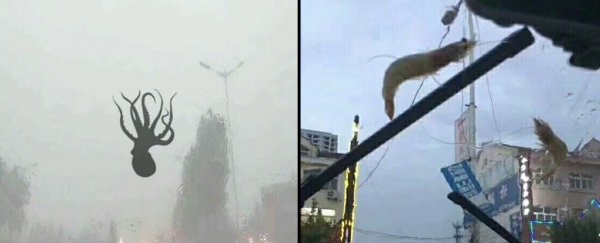Last week, the coastal city of Qingdao in eastern China experienced a massive rainstorm, complete with sea creatures allegedly falling from the sky amidst the buffeting winds and heavy rainfall.
Residents took to social media with photos of this 'seafood rain' bounty, which included prawns and starfish splatted against car windscreens, and even a dramatic octopus-falling-from-the-sky photo.
While the octopus image is a fun but obvious fake (here's the stock silhouette used), it's still possible the city streets did get pelted by some prawns - it's far from the first time seafood rain has been reported in human history.
我们这里的天气也是非常强了……人家下雨下冰雹,我们这里下海鲜…… pic.twitter.com/cmzcovduEU
— 鉴黄师YM (@YM_Ghost) June 13, 2018
Nature doesn't stop at throwing fish at us, either. Past reports have also involved raining frogs, dead birds, worms, and even spiders (we'll get to those a bit later).
Such bizarre "rain of animals" events are considered to be pretty rare, though. And frustratingly, scientists still don't actually have direct evidence of the causes, although there are some plausible hypotheses going around.
Typically, rain happens when water has evaporated from the surface of Earth and the vapour cools down and condenses in the atmosphere, eventually falling back down. Rainwater is not perfectly pure, since those water vapours can trap other particles, such as the pollution that causes acid rain.
But any sort of animal would be too heavy to rise to the heavens in this fashion, so we have to look to more extreme weather for an explanation, such as gale-force winds and tornadoes.
The most typical explanation for a seafood rain involves tornadic waterspouts - huge columns of swirling wind that form above water and can move inland, usually during a severe thunderstorm.
"Like a tornado, a mature waterspout consists of a low-pressure central vortex surrounded by a rotating funnel of updrafts," explains an article at the US Library of Congress.
"The vortex at the centre of these storms is strong enough to 'suck up' surrounding air, water, and small objects like a vacuum."
While scientifically plausible, for now we don't have any direct observations of this phenomenon. Yet some researchers think you may not even need a waterspout, but any strong-enough updraft of wind should have the power to pick up unwitting sea creatures and deposit them along with stormy weather.
As The Independent reports on this latest storm in Qingdao, wind speeds there reached a tremendous 125 km/h (77 mph) which sits at the top level of the Beaufort scale, indicating hurricane-level speeds.
There are speculations that the seafood rain in this case could have been caused by wind ripping apart a street market with actual seafood, and scattering it across the streets. We deem that extremely plausible.
Not all reports of animal rains are genuine, either - sometimes the aftermath of a storm can bring hordes of frogs or worms out of their usual habitats, or even trigger a walking catfish migration from puddle to puddle. In such cases, none of the critters actually rain down at any point.
As for non-aquatic creatures falling from the skies? In the morbid case of dead bird flocks, these densely packed crowds can get confused by loud sounds or other disturbances and start crashing into each other and into stationary objects, ultimately plummeting to their deaths.
And spider rain doesn't even involve any rain at all. As was the case in Goulburn, Australia (of course it was Australia) in 2015, a 'spider rain' is just millions of baby spiders, airborne on their little silken strands, migrating to a new place to call home.
To be honest, we'd take raining prawns over the spiders any day.
